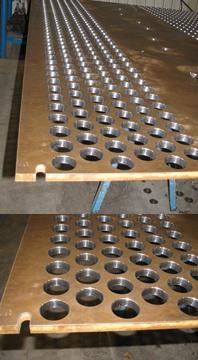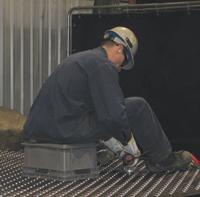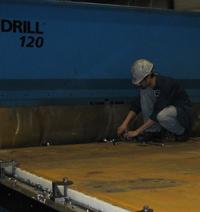- FMA
- The Fabricator
- FABTECH
- Canadian Metalworking
Drilling Plate
Capturing waste heat for power generation and industrial applications starts with OTSG tube support sheets
- April 1, 2010
- Article
- Metalworking
Drilling 2,000 or more holes in inch-thick plate may seem daunting, but at Innovative Steam Technologies (IST), Cambridge, Ont., it’s the daily routine.
Founded in 1992, the company has been producing once-through steam generators (OTSGs) ever since and recently installed its 100th unit worldwide. These generators work in concert with gas-powered turbines to capture waste heat created by the turbine, turning it into usable steam.
The most common application for this steam is power generation, but applications also exist in industries such as pulp and paper to harness and use the steam itself. Compressors also can be run using this steam, expanding its application.
IST manufactures these units from high-grade sheet steel and tubing, creating site-specific units both in terms of size and megawatts (MW) produced.
Lead-time for a unit is nine to 12 months, and each unit can require 6,000 hours of labor. The company produces 10 units per year. Recent installations were in Cuba, Ghana, and Turkey, as well as Canada and the U.S.
Inside an OTSG
Central to the creation of an OTSG are the tube support sheets.
An inside look at one of these steam generators shows a system of tubes. Holding water, these tubes are heated by the waste heat generated from the gas turbine, which turns the water into steam.
These tubes are supported by the tube support sheets, a system of plates that must be aligned perfectly in order to easily install and support the tubing.
Each sheet comprises an array of holes, and at IST, the holemaking is done on a Quickdrill 120-180-15. Installed two years ago by machine tool manufacturer Quickmill, Peterborough, Ont., this machine has made production scheduling, turnaround time, and quality easier to control.
The machine has a Fanuc 0i control, 1,000-PSI through-spindle coolant delivery system, full enclosure with mist collectors, chip conveyor, and a 35-HP quill spindle with a range of 0 to 3,000 RPM.
“We were at the will of our vendors, costs were high, and quality was always a concern,” explained John Hilborn, manager of IST’s OTSG business unit. “Having control of our production is important to us because we have very tight in-house schedules.”
A couple of new orders, particularly large projects, made the justification for the purchase of a new machine easier to swallow. Savings from less outsourced work were easy to track as was the improvement in quality and turnaround times. Now, not only has the system paid for itself in 18 months running one shift, but secondary savings have also been realized.
“We are noticing a savings in logistics costs now because we no longer have to ship our plates,” said Hilborn.
Stainless steel, chromoly, and nickel-alloy plates cost thousands of dollars, which means scrapping a part is unacceptable. A typical tube support sheet is 10 ft. by 12 ft., between 1 and 2 in. thick, and has nearly 2,000 holes.
Setup time is 2.5 hours and is an integral step in the process.
“Setup is vital,” said Bernie Myers, IST production manager. “Drilling is step one in our process so it is important to get it done correctly.”
The drilling operation runs one 10-hour shift per day, which includes setup, drilling, and maintenance of the machine. Three operators at IST are able to run the drilling machine, and they are rotated to keep them fresh.
In any sheet that is produced, multiple hole diameters are needed. Adjustable tooling from tooling supplier Sandvik enables the operator to quickly change the tool diameter slightly to create the different hole sizes that are needed.
“We are not a machine shop, and Quickmill teamed us up with a supplier that came in and understood our needs,” said Hilborn.
The company’s operators make 300 cuts per side on each of the insert’s four sides, and then the inserts are changed. Every 10 holes or so, the operator will use a go/no-go gauge as well as a vernier caliper to ensure quality requirements are met.
After the holes are cut, a worker manually creates a chamfer in each to allow the tubing to slide through more easily and checks the sheet a final time. As the material gets more expensive, more care and checking are required.
“Repeatability is paramount in our tube sheets,” said Hilborn. “We are lining up these sheets across 10 or 12 meters so we need to know that the holes will line up during installation.”
Following 3-D modeling, Myers performs the programming by creating a DXF file that is loaded onto the machine via a memory stick.
The final product is shipped ready to install and can be up and running in the field in four or five weeks, but the process starts with the creation of holes on the company’s drilling machine.
“Two years and 400,000 holes and we are still running smoothly,” said Hilborn.
While IST is owned by construction giant Aecon, the company has a goal to never lose its family atmosphere, and many of the 130 employees have been with the company for more than a decade.
For more information, visit www.otsg.com and www.quickmill.com.
subscribe now


Keep up to date with the latest news, events, and technology for all things metal from our pair of monthly magazines written specifically for Canadian manufacturers!
Start Your Free Subscription- Trending Articles
- Industry Events
MME Winnipeg
- April 30, 2024
- Winnipeg, ON Canada
CTMA Economic Uncertainty: Helping You Navigate Windsor Seminar
- April 30, 2024
- Windsor, ON Canada
CTMA Economic Uncertainty: Helping You Navigate Kitchener Seminar
- May 2, 2024
- Kitchener, ON Canada
Automate 2024
- May 6 - 9, 2024
- Chicago, IL
ANCA Open House
- May 7 - 8, 2024
- Wixom, MI

















